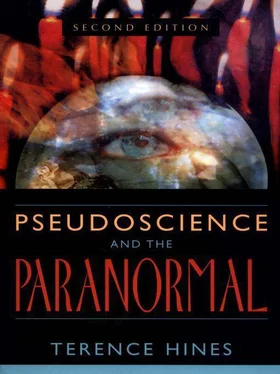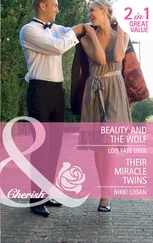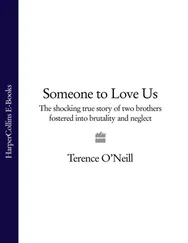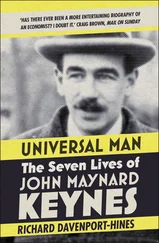While conspiracy theories are not necessarily pseudoscientific or paranormal in nature, they do pop up in the belief systems of many proponents of these claims. The best known example, which will be discussed in chapter 8, is the belief that a vast government conspiracy exists that has kept the real evidence for the extraterrestrial nature of UFOs hidden from the public for the past fifty years or so. In the alternative medicine movement, it is sometimes believed that another conspiracy exists, this time between the government and the drug companies, to keep news of effective treatments for cancer and other dreaded diseases from the public. In general, whether they concern pseudoscientific or paranormal topics or not, the conspiracy theory belief systems do share a major component with the belief systems of other pseudoscientific proponents: their inherent nonfalsiflability. When the alleged evidence for a particular conspiracy has been refuted, the proponent will often point to the very lack of evidence for the theory as evidence for the theory! That is, it is argued that the lack of evidence is not because the theory is false, but instead is due to the supreme effectiveness of the conspiracy itself in seeing to it that no convincing evidence for the conspiracy can be found. In this sort of cloudcuckooland, any belief, no matter how absurd, can be sustained for a very long time indeed.
Since the topic of this book is specifically pseudoscientific and paranormal claims, it would not be appropriate to devote much space to conspiracy theories outside of these areas. However, let me simply make brief note of several excellent works critically examining two of the most well known nonparanormal conspiracy theories, those holding that the Holocaust never happened and that President Kennedy was not killed by a single gunman, Lee Harvey Oswald. Lipstadt (1993) has written a chilling book on the Holocaust denial movement and Shermer (1994) has discussed the factual errors in the claims of the deniers. Posner (1993), in an extremely detailed treatment, discusses the problems with the various claims of a vast conspiracy to kill Kennedy. As is the case with any conspiracy theory, the Kennedy theory requires that a huge number of people be part of the conspiracy and that none of them come forward. Our experience with real conspiracies, such as those underlying Watergate, the Pentagon Papers, and the bombing of Cambodia, show that it is essentially impossible for operations involving very many people to stay secret for long. Gerlich (1998) has written an article discussing some of the specific issues raised by the JFK “conspiracists.” Finally, Pipes (1997) has written a fascinating history of conspiracy theories. I found his discussion of the Freemasons and the Illuminati, two groups conspiracy theorists have loved to hate for centuries, especially interesting. He also provides an excellent history of the Protocols of the Elders of Zion , an antisemitic fraud produced by the Czar’s secret police and first published in 1903.
WHY STUDY PSEUDOSCIENTIFIC CLAIMS?
The serious examination of pseudoscientific and paranormal claims by scientists and scholars who are skeptical about the existence of such phenomena is not a recent development. In the late nineteenth and early twentieth centuries, the claims of spiritualists were carefully scrutinized by several scientists (see chapter 2). A new interest in evaluating pseudoscientific claims arose during the early 1970s as scientists and educators became concerned with the publics’s uncritical acceptance of almost every type of pseudoscientific claim. This resulted in the formation in 1976 of the Committee for the Scientific Investigation of Claims of the Paranormal (CSICOP). The members of CSICOP, including scientists, writers, educators, journalists, and philosophers, founded the organization because of the concern about the “uncritical acceptance by wide sections of the public of many claims of ‘paranormal’ phenomena as true, even without testing” (Kurtz 1976–77, p. 6). The objectives of CSICOP include critical, unbiased, objective research into pseudoscientific claims; the publication of the results of these studies; and a commitment not “to reject on a priori grounds, antecedent to inquiry, any or all [paranormal] claims, but rather to examine them openly, completely, objectively, and carefully” (Kurtz 1976–77, p. 6).
This is very different from the usual approach of scientists and scholars, whose typical response to pseudoscientific claims is simply to dismiss them as nonsense. This latter is a most unfortunate attitude. It is important to examine these claims objectively for at least four reasons. First, the claim may, in fact, be true. Failure to examine it would then delay the acquisition of new, perhaps important, knowledge. Second, if the claim is false, the scientific community, which is heavily supported by the public through taxes, has a responsibility to inform the public. Ignoring a claim and not testing it leaves the field to the promoters of such claims and deprives the public of the information needed to make informed choices. Third, several important psychological issues relate to the study of pseudoscience and the paranormal. Why, for example, do people so strongly believe in theories that not only have no evidence to support them but also have been shown time and again to be flat wrong? Fourth, and finally, the unthinking acceptance of pseudoscientific claims poses real dangers. Believers may act on their beliefs and cause physical harm, even death, to themselves and others. In addition, as our society becomes more dependent on science and technology, we are all threatened by an increase in the uncritical acceptance of clearly incorrect, nonscientific superstitions and related beliefs. The rest of this section will consider in detail these reasons for the study of pseudoscientific claims.
There are several examples in the history of science of phenomena that were once considered to be pseudoscientific or paranormal in nature but were eventually shown to be real, verifiable phenomena of considerable theoretical and practical interest and importance. Perhaps the best example is hypnotism. Hypnotism was first called “mesmerism” after the Viennese physician Franz Anton Mesmer who popularized it in the 1700s. Mesmerism, with its talk of animal magnetism, was clearly a sham (see pp. 374–75), but it did lead to the development of hypnosis, which gained some respectability in the late nineteenth century through its use in psychotherapy. In the twentieth century, especially in the recent decades, the scientific study of hypnosis has expanded greatly. There are now several journals and many books devoted to the topic. As is frequently the case when a pseudoscientific phenomenon is studied carefully and shown to represent a real phenomenon, some initial claims for the phenomenon are found to have been overstated. This is certainly the case with hypnosis, as will be seen in chapter 8. The point here, however, is that there is a true hypnotic phenomenon that is well deserving of study (Nash 2001).
A second example of a phenomenon once scorned but then studied and confirmed scientifically is the case of meteorites. “Stones falling from the skies? Absurd! Ridiculous!” was the common attitude well into the eighteenth century. Hall (1972) has pointed out that reports of stones falling from the skies were once treated by the scientific community with much the same contempt that is now reserved for reports of UFOs. Yet meteorites are clearly real. Might UFOs be real, too? To find out, one has to study the phenomenon, not just dogmatically insist that it is “impossible.”
A final example is acupuncture, the ancient Chinese technique for reducing pain that gained considerable Western attention after then—President Nixon renewed relations between the United States and the People’s Republic of China in the early 1970s. The first reports of this technique certainly sounded unlikely—after all, how could sticking needles in someone reduce his perception of pain? However, experimental work since the early 1970s has suggested that acupuncture for the relief of pain may be a real phenomenon, (pp. 377–78) although again, initial reports of its effectiveness were rather exaggerated.
Читать дальше












